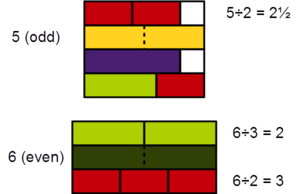Odd number facts for kids
An odd number is a whole number that cannot be divided evenly by two. When you divide an odd number by two, you will always get a fraction or a decimal, not another whole number. For example, if you divide 5 by 2, you get 2.5.
The first odd positive number is one. After that, the next odd numbers are three, five, seven, and nine.
Here are some odd numbers in order:
- 1
- 3
- 5
- 7
- 9
- 11
- 13
- 15
- 17
- 19
- 21
- 23
- 25
Contents
Odd vs. Even Numbers
Numbers that are not odd are called even numbers. An even number is a whole number that can be divided evenly by two. This means when you divide an even number by two, the result is always another whole number. For example, if you divide 6 by 2, you get 3.
Here are some even numbers in order:
- 0
- 2
- 4
- 6
- 8
- 10
- 12
- 14
- 16
How to Spot an Odd Number
It's easy to tell if a number is odd or even just by looking at its last digit.
- An odd number always ends with 1, 3, 5, 7, or 9.
- An even number always ends with 0, 2, 4, 6, or 8.
This rule works for very large numbers too! For example, 1,234,567 is an odd number because it ends in 7. And 98,765,432 is an even number because it ends in 2.
Odd Numbers in Math
Odd and even numbers are part of the set of integers. Integers include all whole numbers, both positive and negative, and zero. This means that negative numbers can also be odd or even.
- For example, -1, -3, and -5 are all odd numbers.
- And -2, -4, and -6 are all even numbers.
You can also find any odd number using a simple math rule. If you take any integer (which we call N) and use the formula 2N+1, you will always get an odd number.
- If N = 0, then 2(0)+1 = 1 (odd)
- If N = 1, then 2(1)+1 = 3 (odd)
- If N = 2, then 2(2)+1 = 5 (odd)
- If N = -1, then 2(-1)+1 = -1 (odd)
This formula helps mathematicians understand how odd numbers are structured.
Images for kids
-
Rubik's Revenge in solved state
See also
 In Spanish: Números pares e impares para niños
In Spanish: Números pares e impares para niños



